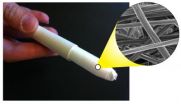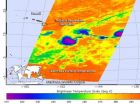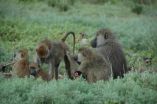(Press-News.org) Everybody knows the shortest distance between two points is a straight line, and now Harvard researchers have evidence that sperm have been taking the familiar axiom to heart.
Though competition among individual sperm is usually thought to be intense, with each racing for the chance to fertilize the egg, Harvard scientists say in some species, sperm form cooperative groups that allow them to take a straighter path to potential fertilization.
A new study, conducted by Heidi Fisher, a post-doctoral student working in the lab of Hopi Hoekstra, Howard Hughes Investigator and Professor of Organismic and Evolutionary Biology and Molecular and Cellular Biology and the Alexander Agassiz Professor of Zoology in the Museum of Comparative Zoology and post-doctoral student Luca Giomi working with L Mahadevan, the Lola England de Valpine Professor of Applied Mathematics, of Organismic and Evolutionary Biology, and of Physics shows that in Peromyscus maniculatus, a species of deer mouse known to be promiscuous sperm clump together to swim in a more linear fashion. The study is described in a July 23 paper in Proceedings of the Royal Society B.
"We generally think that each individual sperm cell swims its little heart out to get to the egg," Hoekstra said. "But it had been discovered that, in at least a handful of organisms, sperm will cooperate and swim as a group."
Exactly why sperm clump together, however, had remained a mystery – until now.
"We had some hints that cooperation was enhancing their swimming performance, but what we didn't understand was how it was helping," Fisher said. "With this study, we combined a mathematical model with much finer-scale measurements that looked at groups that ranged from single sperm cells to groups of as many as 30 cells. What we realized was that that while their overall speed wasn't increasing at all, but that the time it took them to go from point A to point B was decreasing -- they swim in a straighter line."
The study, also found that sperm from promiscuous mice were more likely to form clumps of the optimum size, and that, when compared with sperm from Peromyscus polionotus – a closely-related, but monogamous, species of mouse – the trait is likely driven by sexual selection.
The new paper builds on a 2010 study conducted in Hoekstra's lab which found that sperm cells preferentially clump with those produced by the same male. Spurred by that earlier paper, Mahadevan approached Hoekstra with the idea of creating a mathematical model to understand whether and how sperm received an advantage by forming groups.
"I read the paper and thought we could make a quantitative theory of the observations they had made," he said. "But of course, the only way to know whether any model was capable of anything predictive was to make it testable.
"In this context…the question was: Is it possible to make the aggregate do better than then individual?" he continued. "One way to do that is to get all the tails to synchronize, but that doesn't happen. The other way is to cancel out the random motion of the individuals in an aggregate because the sperm adhere to each other. Eventually, for large aggregates, the sperm point towards each other and thus cannot swim at all. This mechanism when quantified in a model that Luca and I developed and this led to testable predictions., When Heidi did the experiment, we found that this was essentially correct."
In addition to finding that sperm which group together to swim in a more linear fashion, researchers were able to identify at what clump size sperm reaped the largest reward for grouping together. Groups with too few cells, Hoekstra said, continued to swim along more meandering paths, while much larger groups often resulted with sperm swimming against each other.
"What we found is that both species have an optimum at around eight, which was what the model predicted, but there were many fewer groups that were too big or too small in the promiscuous species," she said. "That is consistent with the idea that sexual selection is driving this trait in the promiscuous species, whereas in the monogamous species, where there's not as much competitive pressure, things are a bit more relaxed, so we see more variance in the clump sizes."
In the end, Mahadevan said, the study represented an ideal collaboration between the theoretical and the empirical.
"If you talk to evolutionary biologists, their approaches are often genetic, because they're trying to understand what the genetic bases are for natural selection pressures," he said. "From a theoretical point of view, the focus is on reproductive capacity. What's interesting in this particular situation is we can take a question of reproductive capacity and add a physiological twist to it that's associated with sperm motility, and then we can take that apart in the context of what happens when you change the shape of the sperm, or their ability to adhere to each other, or their ability to move."
"In my view we haven't so much answered the question as we've sharpened it," he continued. "And we've done by that couching a conceptual notion of competition and cooperation in terms of physical and physiological variables that can be measured and lead to testable predictions."
INFORMATION:
When cooperation counts
Researchers find sperm benefit from grouping together in mice
2014-07-30
ELSE PRESS RELEASES FROM THIS DATE:
Scientists call for new strategy in pursuit of HIV-free generation
2014-07-30
In light of the recent news that HIV has been detected in the Mississippi baby previously thought to have been cured of the disease, researchers are assessing how to help those born to HIV-infected mothers. These infants around the world are in need of new immune-based protective strategies, including vaccines delivered to mothers and babies and the means to boost potentially protective maternal antibodies, say researchers who write in the Cell Press journal Trends in Microbiology on July 30th.
"There is a real need for additional HIV-1 prevention methods for infants," ...
Study: Marine pest provides advances in maritime anti-fouling and biomedicine
2014-07-30
A team of biologists, led by Clemson University associate professor Andrew S. Mount, performed cutting-edge research on a marine pest that will pave the way for novel anti-fouling paint for ships and boats and also improve bio-adhesives for medical and industrial applications.
The team's findings, published in Nature Communications, examined the last larval stage of barnacles that attaches to a wide variety of surfaces using highly versatile, natural, possibly polymeric material that acts as an underwater heavy-duty adhesive.
"In previous research, we were trying to ...
Dissolvable fabric loaded with medicine might offer faster protection against HIV
2014-07-30
Soon, protection from HIV infection could be as simple as inserting a medicated, disappearing fabric minutes before having sex.
University of Washington bioengineers have discovered a potentially faster way to deliver a topical drug that protects women from contracting HIV. Their method spins the drug into silk-like fibers that quickly dissolve when in contact with moisture, releasing higher doses of the drug than possible with other topical materials such as gels or creams.
"This could offer women a potentially more effective, discreet way to protect themselves from ...
NASA sees zombie Tropical Depression Genevieve reborn
2014-07-30
Infrared imagery from NASA's Aqua satellite helped confirm that the remnant low pressure area of former Tropical Storm Genevieve has become a Zombie storm, and has been reborn as a tropical depression on July 30.
Tropical Storm Genevieve weakened to a tropical depression on Sunday, July 27 and the National Hurricane Center issued their final advisory on the system as it was entering the Central Pacific. Now, after three days of living as a remnant low pressure area, Genevieve reorganized and was classified as a tropical depression again.
The Tropical Rainfall Measuring ...
Birthweight and breastfeeding have implications for children's health decades later
2014-07-30
Young adults who were breastfed for three months or more as babies have a significantly lower risk of chronic inflammation associated with cardiovascular and metabolic diseases, according to research from the Brown School at Washington University in St. Louis.
"This study shows that birthweight and breastfeeding both have implications for children's health decades later," said Molly W. Metzger, PhD, assistant professor at the Brown School and a co-author of the study with Thomas W. McDade, PhD, of Northwestern University.
"Specifically, we are looking at the effects ...
Appreciation for fat jokes, belief in obese stereotypes linked
2014-07-30
BOWLING GREEN, O.—From movies to television, obesity is still considered "fair game" for jokes and ridicule. A new study from researchers at Bowling Green State University took a closer look at weight-related humor to see if anti-fat attitudes played into a person's appreciation or distaste for fat humor in the media.
"Weight-Related Humor in the Media: Appreciation, Distaste and Anti-Fat Attitudes," by psychology Ph.D. candidate Jacob Burmeister and Dr. Robert Carels, professor of psychology, is featured in the June issue of Psychology of Popular Media Culture.
Carels ...
Many depressed preschoolers still suffer in later school years
2014-07-30
Children diagnosed with depression as preschoolers are likely to suffer from depression as school-age children and young adolescents, new research shows.
Depressed preschoolers were 2.5 times more likely to suffer from the condition in elementary and middle school than kids who were not depressed at very young ages, according to researchers at Washington University School of Medicine in St. Louis.
Their study is published in the July issue of the American Journal of Psychiatry.
"It's the same old bad news about depression; it is a chronic and recurrent disorder," ...
Penn researchers: Naltrexone may diminish impulse control disorders in Parkinson's disease patients
2014-07-30
(PHILADELPHIA) – Up to 20 percent of Parkinson's disease (PD) patients and their families may confront a common but largely unrecognized challenge: the occurrence of impulse control disorders (ICDs) such as compulsive gambling, sexual behavior, eating, or spending. Yet the presence of PD in these patients can severely limit or complicate treatment options. A team of investigators from the Perelman School of Medicine at the University of Pennsylvania and the Parkinson's Disease Research, Education and Clinical Center (PADRECC) at the Philadelphia Veterans Affairs Medical ...
Study: Telephone support program beneficial for caregivers of those with dementia
2014-07-30
PROVIDENCE, R.I. – Rhode Island Hospital researchers have found that a support program administered entirely by telephone can significantly reduce depression and other symptoms in informal caregivers, such as family or friends, of individuals with dementia. The study is published online in advance of print in the journal Alzheimer's & Dementia.
"Those caring for people with Alzheimer's disease or other forms of dementia are often under a great deal of pressure," said principal investigator Geoffrey Tremont, Ph.D, of the division of neuropsychology in the department of ...
Supportive moms and sisters boost female baboon's rank
2014-07-30
DURHAM, N.C. -- A study of dominance in female baboons suggests that the route to a higher rank is to maintain close ties with mom, and to have lots of supportive sisters.
A female baboon's social status is dictated not by size or strength, but by the rank of her mother -– the higher the mother is ranked, the higher-ranked her daughter will be. For this reason, dominance rank in female baboons is thought to be determined at birth. Females born to high-ranking mothers are guaranteed a good spot in the pecking order, whereas females born to low-ranking mothers are usually ...
LAST 30 PRESS RELEASES:
Air pollution exposure and birth weight
Obstructive sleep apnea risk and mental health conditions among older adults
How talking slows eye movements behind the wheel
The Ceramic Society of Japan’s Oxoate Ceramics Research Association launches new international book project
Heart-brain connection: international study reveals the role of the vagus nerve in keeping the heart young
Researchers identify Rb1 as a predictive biomarker for a new therapeutic strategy in some breast cancers
Survey reveals ethical gaps slowing AI adoption in pediatric surgery
Stimulant ADHD medications work differently than thought
AI overestimates how smart people are, according to HSE economists
HSE researchers create genome-wide map of quadruplexes
Scientists boost cell "powerhouses" to burn more calories
Automatic label checking: The missing step in making reliable medical AI
Low daily alcohol intake linked to 50% heightened mouth cancer risk in India
American Meteorological Society announces Rick Spinrad as 2026 President-Elect
Biomass-based carbon capture spotlighted in newly released global climate webinar recording
Illuminating invisible nano pollutants: advanced bioimaging tracks the full journey of emerging nanoscale contaminants in living systems
How does age affect recovery from spinal cord injury?
Novel AI tool offers prognosis for patients with head and neck cancer
Fathers’ microplastic exposure tied to their children’s metabolic problems
Research validates laboratory model for studying high-grade serous ovarian cancer
SIR 2026 delivers transformative breakthroughs in minimally invasive medicine to improve patient care
Stem Cell Reports most downloaded papers of 2025 highlight the breadth and impact of stem cell research
Oxford-led study estimates NHS spends around 3% of its primary and secondary care budget on the health impacts of heat and cold in England
A researcher’s long quest leads to a smart composite breakthrough
Urban wild bees act as “microbial sensors” of city health.
New study finds where you live affects recovery after a hip fracture
Forecasting the impact of fully automated vehicle adoption on US road traffic injuries
Alcohol-related hospitalizations from 2016 to 2022
Semaglutide and hospitalizations in patients with obesity and established cardiovascular disease
Researchers ‘listen in’ to embryo-mother interactions during implantation using a culture system replicating the womb lining
[Press-News.org] When cooperation countsResearchers find sperm benefit from grouping together in mice





